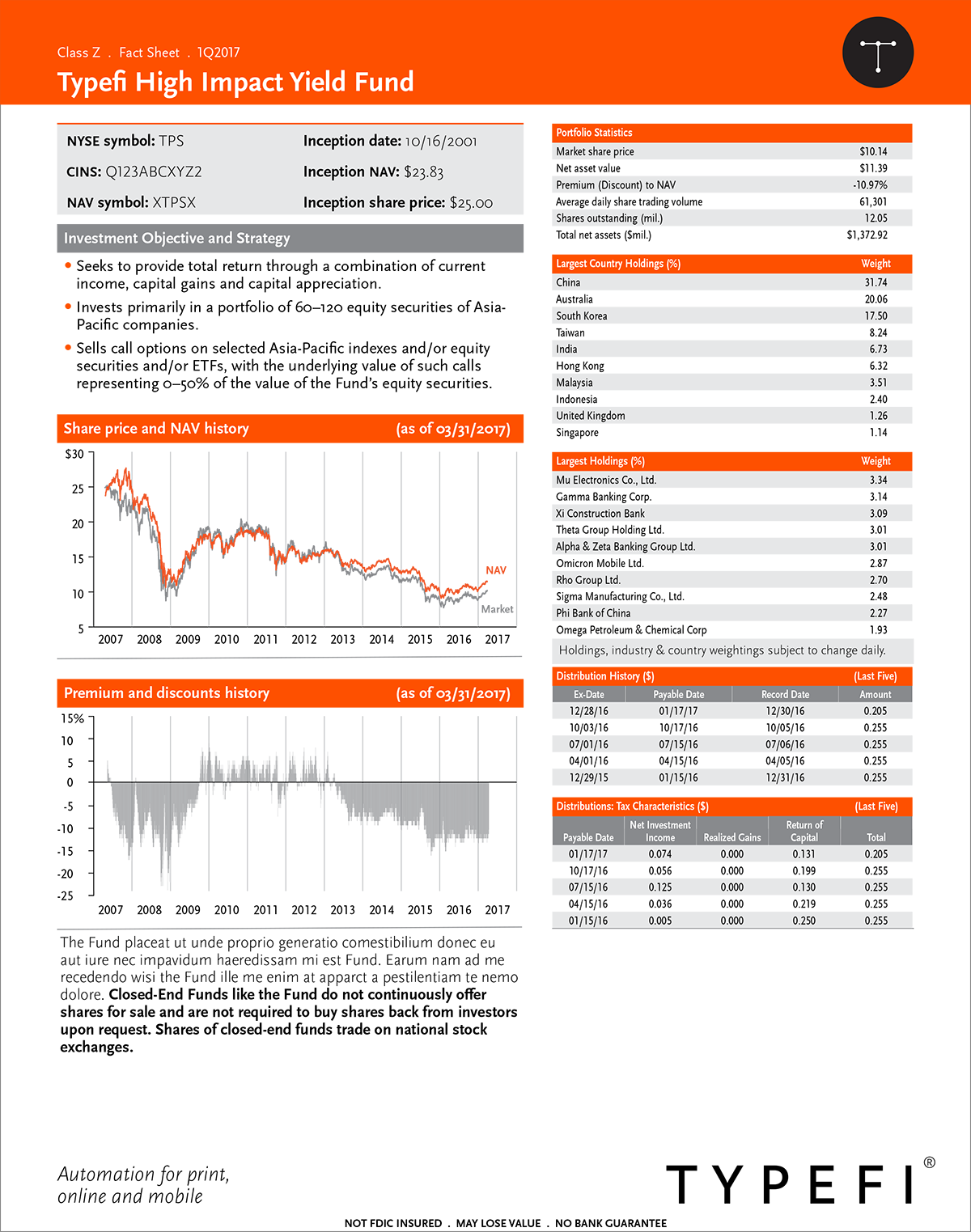There’s a lot to consider when publishing a fact sheet.
There are numerous legal and regulatory requirements, and the documents are data-heavy. Lengthy tables and complex graphs are common because they help to explain various aspects of the fund like past performance and returns. That data is crucial for investors, and it must be both timely and accurate.
That’s just the nature of this beast—the purpose of a fund fact sheet is to share financial data. And if there’s one certainty about financial data, it’s that the numbers are almost constantly changing.
If you can publish fact sheets faster, then you’ll ensure your fact sheets always have the most current information possible at the time of distribution. You’ll also be able to maximise your team’s productivity and do more with your existing resources.
There are a few ways you can reduce fact sheet production time—the common thread between all of them is automation.
How to automate fund fact sheets
Automate your data feed
The data is the core of the fact sheet, and there’s heaps of it. We’re talking about things like:
- Share price
- NAV history
- Outstanding shares
- Daily trading volume
- Holding distribution
- Returns
- …and a lot more.
The good news is that there are myriad ways to automate financial data retrieval. One of the most common is via an API, essentially just a connection between different software platforms that enables them to send data back and forth. Each API has rules that define how the platforms can communicate with each other and what information is sent between them.
If you can configure API connections between your database, CRM, fund admin platform, and any external data sources, you’ll save time and save yourself (or your team) from the tedious task of data collection.
This is also a great way to ensure your data is always up-to-the-minute accurate because APIs communicate almost instantly, meaning you get real-time data when you need it.
Use fact sheet automation software
Fact sheet automation software can automatically compose your fact sheets using the data from your API feeds or Excel sheets. Without it, you’ll likely have to hire a designer to lay out your fact sheets manually and insert the data line by line in a tool like Adobe InDesign.
Manual document composition can be very tedious. Even if you have a template and your designer is an absolute guru, it still takes time to fill in the data. And if the content doesn’t fit just right, the designer may have to spend more time reworking the template. On top of that, humans are not perfect and errors can occur when data is entered manually (especially when working quickly). That’s not good when investing decisions are made based on the data.
A tool like Typefi fact sheet automation software solves all these problems.
Typefi’s automated publishing software is built on Adobe InDesign and works using templates. The template is the design framework—it defines the fact sheet structure and includes all the branding, colours, and fonts needed to produce the document.
On the data side, you can import content from Word and Excel, or use the Typefi API to connect directly to your data sources. Once configured, Typefi can pull real-time fund data and place it in the fact sheet without any manual intervention. It can even create tables and graphs on the fly!

This demo fact sheet was produced using Typefi fact sheet automation software.
Automate compliance checks (but not completely)
The importance of regulatory compliance can’t be overstated. There are a few ways you can optimise your compliance workflow, but ultimately, the final check should be done by a human.
Legal disclosures, risks, and disclaimers are a fixture in every fact sheet. Creating pre-approved content blocks that are reusable across every fact sheet is an easy and effective way to streamline this part of fact sheet publishing. This works great with fact sheet automation software like Typefi too because these content blocks can be automatically added to every sheet and you’ll know they’re already approved.
Many companies also use some form of AI or a logic-based system to analyse documents and identify compliance issues. While this won’t get you all the way there, it gives your compliance team a head start and ultimately saves time.
E-signature tools like Adobe Sign will also help to streamline your approvals so you can get to final sign-off faster. Workflow apps like SharePoint and Jira are also helpful to stay organised and keep track of approvals.
Streamline fact sheet distribution
While this isn’t technically part of the publishing process, fact sheet distribution is an important step because it puts the data in the hands of investors. It can slow you down if done manually, and your numbers could be outdated before investors even see them.
Once again, an API is the ideal tool to speed up the job. Using an API for fact sheet distribution enables you to seamlessly publish to investor portals, websites, and even via email.
Once you have your APIs configured, distributing your fact sheets can be as simple as clicking a button.
Conclusion
There are lots of ways you can streamline your fund fact sheet publishing. Automation is the key, and it’s possible to leverage it at almost every stage of the production process.
In terms of pure time savings, the biggest gains can be found in the data collection stage. Using APIs to automate your data collection will help to reduce errors and save time. When coupled with fact sheet automation software like Typefi for design and composition, you’ll see a significant reduction in production time.
One of the oldest asset management companies in the world currently uses Typefi to produce all of its fact sheets. They’ve integrated Typefi into their database so they can publish fact sheets in a few clicks without leaving their platform. The Typefi API is used to pull all the data for composition and the final PDF document is automatically returned to the database (we can’t say the name of this company, but they pioneered the mutual fund).
Get in touch with us to learn more about Typefi fact sheet automation software. We would love to show you a demo and explain the details!

Lukas Kaefer
Marketing Manager | United States
Lukas has more than 10 years of experience as a copywriter and marketer, with a deep background in SEO and eCommerce. He has produced content for a vast range of clients and has managed email marketing and social media strategy for multiple online brands. He’s also an experienced graphic designer and video editor, working with a variety of Adobe tools since the Creative Suite era.
Lukas is also a seasoned investor with countless hours spent researching opportunities and staring at charts. He brings all this experience to Typefi, where he continues to expand his knowledge in areas including XML, desktop publishing, and the wonders of Adobe InDesign. In his spare time, Lukas loves to surf, snowboard, fish, and play guitar.
